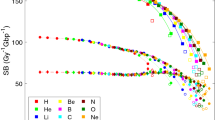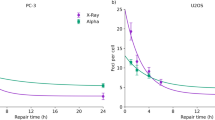Abstract
The cumulative radiation effect (CRE) is one of several empirical scalar descriptions of biological effect which enable corrections to be made for gaps in radiotherapy treatment. Predictions of this theory were tested using mouse crypt regeneration and mouse skin as biological models. These experimental results are discussed in terms of the dependence of tissue regeneration potential during a gap on the biological effect achieved before the gap, and on gap length. A hypothesis is proposed to reconcile the apparent conflict between the two experiments. While the simple exponential gap formulation of the CRE is seen to be inadequate, insufficient data are available at present to modify it.
This is a preview of subscription content, access via your institution
Access options
Subscribe to this journal
Receive 24 print issues and online access
$259.00 per year
only $10.79 per issue
Buy this article
- Purchase on SpringerLink
- Instant access to full article PDF
Prices may be subject to local taxes which are calculated during checkout
Similar content being viewed by others
Rights and permissions
About this article
Cite this article
Perry, A., Hamlet, R. & Kirk, J. Investigation of time-gap formulae on the CRE system using mouse tissue as a biological model. Br J Cancer 40, 649–657 (1979). https://doi.org/10.1038/bjc.1979.231
Issue Date:
DOI: https://doi.org/10.1038/bjc.1979.231



